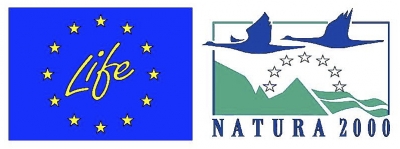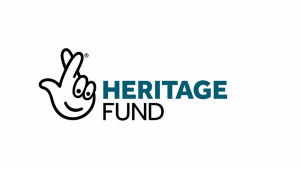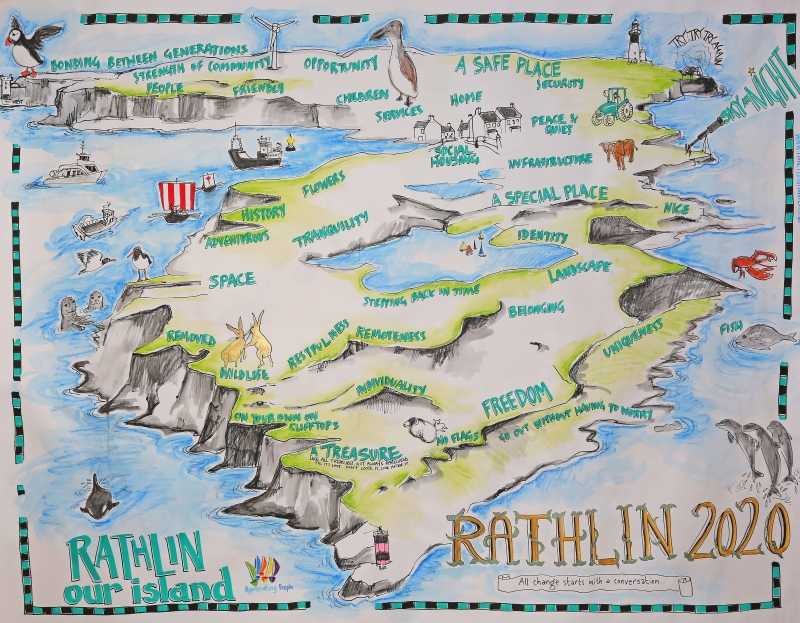Major Conservation Project for Rathlin Island Gets Green Light
Thursday 9th September 2021
Media Release from the LIFE RAFT Project:

Major Conservation Project for Rathlin Island Gets Green Light
A £4.5 million conservation project that will safeguard Rathlin Island’s internationally important
seabird population and wildlife has been given the go ahead, following major funding.
The partnership project, known as Rathlin Acting for Tomorrow (LIFE RAFT), has received funding
from EU LIFE, The National Lottery Heritage Fund (development phase) and Department of
Agriculture, Environment and Rural Affairs (DAERA), with contributions from RSPB NI, Rathlin
Development and Community Association (RDCA) and Causeway Coast and Glens Heritage Trust
(CCGHT).
This £4.5 million island restoration project is set to be the largest-of-its-kind on the island of Ireland
and will be delivered over five years. Focusing on natural heritage and community, the initiative will
help Rathlin Island’s economic recovery following the impact of Covid-19, while protecting its
important wildlife.
Rathlin is known as a haven for wildlife, including many threatened species, and hosts Northern
Ireland’s largest seabird colony, which is one of the most important breeding sites in both the UK
and Ireland. However, its wildlife is under threat, including 25 bird species and notably the puffin
which has declined by more than half in recent years1. One of the key threats is from predation by
invasive non-native species.
The project will safeguard Rathlin’s seabirds and ground-nesting birds that are under threat through
a brown rat and ferret eradication programme. With 70% of visitors to Rathlin citing birds and
wildlife as their main reason for visiting, by restoring Rathlin’s natural heritage, the project will bring
benefits for the local community2.
Michael Cecil, who chairs the RDCA and is the partnership representative, said: “As a community,
Rathlin Islanders are proud to protect our natural heritage. We can see how it sustains our
community and makes Rathlin a very special island. This project will help protect our livestock and
crops, create over 30 jobs3, increase on island spend and further promote Rathlin as a leader in ecotourism whilst boosting our recovery from Covid-19. We hope this project will make Rathlin an even
better place to live, work and visit.”
The project will be led by the expert conservation charity, RSPB, which has experience in similar
island restoration projects on the Isles of Scilly, the Shiant Isles and most recently on Gough Island in
the Tristan da Cunha archipelago in the South Atlantic Ocean. The RSPB has been working on Rathlin
Island for over 25 years.
RSPB NI’s Claire Barnett, Project Executive for LIFE RAFT, commented, “Bringing this global-scale
conservation project to Northern Ireland is vital to safeguard the amazing wildlife on Rathlin. We
would like to thank the local community, our partners and our funders for their support. Together, we
will protect and promote Rathlin’s internationally important wildlife and landscape so future
generations can enjoy seeing guillemots, razorbills, kittiwakes and the iconic puffins and possibly
even the return of locally extinct species such as Manx shearwaters and storm petrels, which were
once common on the island.”
Agriculture, Environment and Rural Affairs Minister Edwin Poots MLA commented: “Rathlin is a very
special place for wildlife and I’m delighted that my Department has provided funding totalling
£537,374 towards this project. I would like to thank the Rathlin community and the project partners
for the significant effort they have made to develop this project and secure the funding. Together we
can work to restore the Island’s seabirds and support the community in its recovery from the Covid19 pandemic.”
Graham Thompson, Chief Executive of Causeway Coast and Glens Heritage Trust added, “This is a
hugely important project for Rathlin, the Antrim Coast and Glens, Northern Ireland and the island of
Ireland. The formal starting point has been a long time coming; there have been almost 10 years of
hard work, research and development to get us where we are today. Key to this project has been and
will continue to be the constructive partnership approach engaged by all partners including the RSPB,
DAERA, CCGHT and by far most importantly the entire Rathlin Island community.”
Speaking on behalf of The National Lottery Heritage Fund, Mukesh Sharma, Chair, Northern Ireland
said, “We are delighted to support RSPB NI and its partners as they embark on a new project to
protect the native natural heritage on Rathlin Island. With the help of funds raised by National
Lottery players, this project has the potential to make a significant difference for the local community
and visitors, and we’re looking forward to working with the Rathlin team as it develops.”
The project has entered a development phase and operations will commence in 2022. This is just
one of the projects that Rathlin Island is undertaking to protect, support and enhance the
community and its unique environment, including actions to become carbon neutral by the end of
the decade. For more information visit www.rathlincommunity.org/rdca or www.rspb.org.uk/NI.
ENDS
For more details please contact:
Angela Mahon, RSPB NI Communication Officer, angela.mahon@rspb.org.uk, 07736 477 526
or
Kathryn Cochrane, RSPB NI Communications Manager, kathryn.cochrane@rspb.org.uk
07702 822 873
Captions and soundbites available on distribution.
Additional Notes
About Rathlin Island
• Rathlin Island is situated off the north east coast of Northern Ireland and is its only inhabited
offshore island in Northern Ireland and is home to over 150 residents. The community of
Rathlin has a history of protecting its natural heritage and managing the land sustainably.
• It is by far the largest seabird colony in Northern Ireland and remains one of the most
important seabird breeding sites in the UK and Ireland. Rathlin Island is home to
approximately 200,000-250,000 breeding seabirds.
• The island has a range of designations and protections that cover the whole island or certain
areas to protect its special habitats, species and landscape which include Special Protected
Area (SPA), Special Area of Conservation (SAC), Marine Conservation Zone (MCZ), Areas of
Special Scientific Interest (ASSI) and it is within an Area of Outstanding Natural Beauty
(AONB).
• Rathlin Island is designated as a Special Protection Area in support of nationally important
numbers of peregrine falcons, internationally important breeding numbers of migratory
razorbills, guillemots and kittiwakes and over 5,000 other breeding seabirds.
• The island is also protected as a Marine Conservation Zone as it supports a large population
of black guillemots that nest within the Island’s cliffs.
• Manx shearwaters also bred on Rathlin up until the 1980s, potentially into their thousands
but have been extirpated due to predation.
• These seabird colonies are critically important components of island biodiversity and
support island ecosystems. Healthy seabird colonies often bring visitors to an area for
wildlife tourism and provide a great way to connect with nature.
About the project
• Both rats and ferrets were introduced to the island and are not part of the natural
ecosystem of Rathlin. They predate wildlife including seabirds, land birds and mammals such
as pygmy shrews; ferrets predate livestock such as chickens; rats eat crops and cause
damage to homes; both carry and risk spreading diseases.
• Removing rats and ferrets will protect important wildlife species, protect community
livestock and crops, plus prevent the spread of diseases. Local communities are important in
ensuring the success of such a large-scale invasive non-native species removal projects.
• In two separate prioritisation exercises, Rathlin Island was identified as the top priority
island in Northern Ireland for eradication of invasive non-native predatory species4, 5. For the
island of Ireland context, Kelly6 identified Rathlin Island as joint priority along with Lambay
Island in the Republic of Ireland. For the UK as a whole, Stanbury identified Rathlin Island as
the 4th highest priority island for this type of conservation intervention7. This was out of 955
UK islands known to have invasive mammals and threatened species.
• In 2010 the estimated annual cost of invasive non-native species to the British economy was
£1.7 billion per annum8. Similarly, the combined annual cost of invasive non-native species
on the economies of Northern Ireland and the Irish Republic was estimated at £207 million
per annum9.
About RSPB NI
The RSPB is the UK’s largest nature conservation charity, inspiring everyone to give nature a home.
Together with our partners, we protect threatened birds and wildlife so our towns, coast and
countryside will teem with life once again. It plays a leading role in BirdLife International, a
worldwide partnership of nature conservation organisations.
The RSPB has been operating in Northern Ireland for 50 years to inspire a world richer in nature. It is
an important voice for the environment in NI and works with partners and local communities to help
birds, other wildlife and natural places survive and thrive. It has over 10,000 members, around 60
employees and 300 volunteers and manages 10 reserves, which are important homes for wildlife
and allow visitors to engage with nature through a range of activities and events. For more
information visit www.rspb.org.uk/northernireland.
About RDCA
The Rathlin Development & Community Association (RDCA) is the voluntary body that represents the
Rathlin community and lobbies for improvements to services and infrastructure etc. The Rathlin
Community Association was established in 1978 and after alterations to the constitution, its name
changed in 1986 to the Rathlin Development and Community Association. The RDCA is a charity,
recognised by the NI Charity Commission and HMRC. The RDCA is primarily concerned with:
• Improving the quality of life for those living on the island.
• Ensuring that basic services and infrastructure are provided.
• Encouraging appropriate economic development.
LIFE
The EU programme for the environment and climate action. Created in 1992, it has co-financed
hundreds of projects right across Europe.
https://cinea.ec.europa.eu/life_en.

National Lottery Heritage Fund
The National Lottery Heritage Fund is the largest dedicated grant funder of the UK’s heritage. It
distributes National Lottery grants from £3,000 to £5million and over, funding projects that sustain
and transform the UK's heritage. It distributes other UK heritage funding, for example of behalf of
governments. It provides leadership and support across the heritage sector, and advocate for the
value of heritage.
Understanding, valuing and sharing our heritage brings people together, inspires pride in
communities and boosts investment in local economies. It’s supporting the heritage sector to
strengthen its recovery from the coronavirus (COVID-19) pandemic and build back for positive
change.

About DAERA
The Department of Agriculture, Environment and Rural Affairs (DAERA) has responsibility for food,
farming, environmental, fisheries, forestry and sustainability policy and the development of the rural
sector in Northern Ireland. The Department assists the sustainable development of the agri-food,
environmental, fishing and forestry sectors of the Northern Ireland economy, having regard for the
needs of the consumers, the protection of human, animal and plant health, the welfare of animals
and the conservation and enhancement of the environment.
Causeway Coast and Glens Heritage Trust
The Causeway Coast and Glens Heritage Trust was established in May 2002 as a partnership body
with the responsibility of promoting and enhancing the unique qualities of the Causeway Coast and
Glens area. Within the Trust’s boundary, which encompasses an area of more than 3400 km², there
exists a wide variety of scenic landscapes, important wildlife resources and a rich cultural heritage.
1 RSPB NI research based on data from British Trust of Ornithology, Allen D., Archer E., Leonard K. & C. Mellon (2011) Rathlin Island Seabird Census 2011. Allen & Mellon Environmental Ltd., NIEA Report and NI Seabird Report 2018, Port, L.N. (1959) A population and distribution of birds on Rathlin Island. The Irish Naturalists’ Journal 13:92-99.
2 Fallows, 2019//RSPB NI (2019) –
3 A minimum of 36 new staff roles will be created to deliver this project (project team x 5, conservation x 31)
4 Kelly, J., Maguire, C.M. and Cosgrove, P.J. (2008). Invasive Predatory Mammals on Islands Strategy. Unpublished report prepared for Northern Ireland Environment Agency and National Parks and Wildlife Service as part of Invasive Species Ireland
5 Stanbury et al (2017)
6 Kelly, J., Maguire, C.M. and Cosgrove, P.J. (2008). Invasive Predatory Mammals on Islands Strategy. Unpublished report prepared for Northern Ireland Environment Agency and National Parks and Wildlife Service as part of Invasive Species Ireland
7 Stanbury et al (2017)
8 Williams, F. et al. (2010). The economic cost of invasive non-native species on Great Britain. Technical Report CAB/001/09.
9 Kelly, J., Tosh, D., Dale, K., Jackson, A. (2013). The economic cost of invasive and non-native species in Ireland and Northern Ireland. A report prepared for the Northern Ireland Environment Agency and National Parks and Wildlife Service as part of Invasive Species Ireland.






